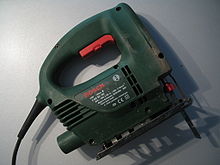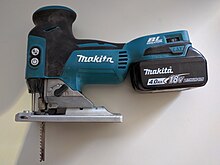Jigsaw (power tool)
It has been suggested that this article be merged with Jigsaw (tool). (Discuss) Proposed since June 2014. |
This article appears to contradict the article Sabre saw. (July 2014) |



A jigsaw power tool is a jigsaw made up of an electric motor and a reciprocating saw blade.
A jigsaw with a bevel function on the sole plate allows cutting angles of typically up to 45 degrees relative to the normal vertical stroke for cutting miter joints.
In the past, what are now usually called scroll saws were often referred to as jigsaws.
A power jigsaw may also be referred to, by some manufacturers, as a "bayonet saw" or sabre saw.[contradictory]
History
In 1946 Albert Kaufmann, an engineer of Scintilla AG company in Solothurn, Switzerland, replaced the needle on his wife's sewing machine with a saw blade.[1][2] In 1947, after development of Kaufmann's invention, Scintilla started producing jigsaws under name "Lesto jigsaw". In 1954 Scintilla was acquired by Bosch and in 1964 the name "Lesto" was replaced with Bosch. In 1966 Bosch added the pendulum action to the blade movement and in 1989 it added the tool-less blade replacement device.
Blades
There are 2 main types of blade fitting in use. The older type uses a screw to hold the blade; the newer type slots in.
A wide variety of blade types are used, including:
- various numbers of TPI (Teeth Per Inch)
- blade edge for cutting soft materials
- cranked blades to overcome the setback of the blade and allow flush cutting
- thin blades to allow tighter curves to be cut
- push stroke cutting blades to avoid damage to the top surface
Controllability
Control is an issue with jigsaws. The blades are small, weak and entirely unsupported at the lower end. Good cut control requires the presence of blade rollers, which keep the blade aligned just above the sole plate. Heavy cast sole plate saws are somewhat better than pressed steel for sawing line control too. To guide a jigsaw on curved cut, it must be steered (turned) and not forced to move sideways. The usage of sharp blades is important also to get high quality cuts.
